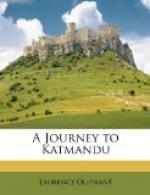We arrived at Dholpoor next day—looked down a magnificent well, about sixty feet in diameter, with corridors round it, and a handsome flight of stairs leading down to them—and then pushed on for Gwalior, crossing the battle-field of Maharajpore, and paying a visit to the fort perched upon the scarped rock. Some portions of the fort walls were covered with various devices in green and yellow porcelain, which added to their singular and characteristic appearance.
We visited the young Rajah in Durbar, and the difference between the Mahratta and Nepaulese Courts was most striking. The waving plumes, hussar jackets, and gold-laced pantaloons of the latter were exchanged for the simple white turban and flowing robe of the Indian senator; but though the character of their costume may have been more in accordance with our ideas of Oriental habits, there was a lamentable deficiency of intellect in their faces, and the fire and intelligence which flashed from the eye of the Highland noble were wanting in that of the Mahratta chief. After two days’ agreeable sojourn at the Residency we proceeded for two or three consecutive nights over flat dreary country, spending the days in the miserable little resthouses provided for the accommodation of the traveller, and generally picking up a few partridges for breakfast.
At Goonah we had a prospect of more important game. We here fell in with a most ardent sportsman: the numerous trophies of bears and tigers with which his bungalow was adorned proved his success as well as his skill.
With him we sallied forth at about 10 A.M., some on horseback and some on an elephant, all equally indifferent to the sun, fiercely blazing in an unclouded sky, and reached a dell, the sides of which were covered with a low scrubby jungle, where sport was to be expected.
As tiger-shooting on foot is almost unheard of in the northern part of India, and is practised in the southern only, because the tiger there is a much less formidable animal than his majesty of Bengal, we were told to proceed with considerable caution by the veteran, who posted us in the most likely places, saying to one of our party, as he stationed him in the most favourable locality, “I put you here because the tiger is nearly sure to charge down this hill; and if he does, there will be very little chance of escape for you, as you see he has so much the advantage of you, that if you do not kill him with either barrel—and the skull of a tiger is so narrow that it is exceedingly improbable you will be able to do so—he must kill you, but I would not for the world that you should miss the sport.”




